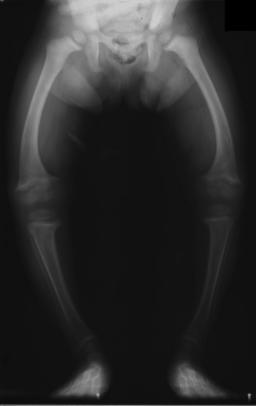CHICAGO -- All exclusively breast-fed infants should receive vitamin D supplementation to prevent rickets, Dr. Susan S. Baker said at the annual meeting of the American Academy of Pediatrics.
This is not a new recommendation. In its 1998 Pediatric Nutrition Handbook, the AAP advised a dose of 400 IU/day. Recent data suggest that the rate of rickets may be rising in the United States, which experts believe is due in large part to a doubling of the breast-feeding rate in the last decade and a reduction in exposure to sunlight.
All toddlers should drink cow's milk or a nutritionally comparable substitute that contains vitamin D, said Dr. Baker, cochief of the division of gastroenterology and nutrition at Children's Hospital of Buffalo, and chair of AAP's Committee on Nutrition.
Rickets is a failure of the bone matrix to materialize, usually due to vitamin D deficiency. At increased risk are dark-skinned infants; those who are not fed milk; and those with heavy skin covering, either by clothing or sunscreen.
Natural vitamin D sources include liver, fatty fish, and some egg yolks. For infants and toddlers, the best sources are fortified foods or supplements. Infant formulas are vitamin-D fortified bylaw, but rice and soy drinks are not, said Dr. Baker, professor of pediatrics at the University of Buffalo.
Mother's milk is best for infants, but the small amount of vitamin D that it contains is not enough to protect against rickets and does not compensate for the amount infants would get if they were exposed to direct sunshine. Supplementing the mother's diet doesn't work because she would have to consume amounts of vitamin D that could be toxic for her over several months of breast-feeding, she said.
The word "rickets" conjures up images of poor children raised during the Industrial Revolution in tenements with poor air quality, poor food, and crowded conditions. In fact, the disease killed between 13,000 and 14,000 children of all socioeconomic classes between 1910 and 1961. It began to decline after that but never disappeared completely.
Now, worrisome data from the Centers for Disease Control and Prevention suggest a possible resurgence. In Georgia between January 1997 and June 1999, hospital discharge summaries identified six male infants (aged 7-21 months) with primary nutritional deficiency and rickets. They were of varying socioeconomic status, with yearly household incomes ranging from $10,000-$50,000. All had been breastfed for 7-19 months, and were consuming unfortified milk substitutes at the time of hospitalization.
Of the 30 cases of rickets diagnosed in North Carolina in the last 10 years, 18 (60%) were diagnosed in the last 18 months. All were exclusively breast-fed, term African American infants. All had increased alkaline phosphatase, 60% had hypocalcemia, and 96% had hypophosphatemia. Many had skeletal abnormalities and seizures.
Since it is now recommended that infants not be exposed to the sun because of concerns about skin cancer, "we really need to look more to dietary sources for vitamin D as an essential nutrient," she said.
Since the disease of rickets is not reportable, there are likely to be many other cases that are not quite as severe as these. Moreover, biochemical and physiologic abnormalities often develop long before clinically apparent disease. The Georgia and North Carolina cases "are probably just the tip of the iceberg," Dr. Baker said.
Physicians should look for biochemical signs of rickets in infants or toddlers who are at risk but who don't appear clinically to have the disease. In mild rickets, serum calcium levels are decreased, parathyroid hormone is increased, and phosphorus remains normal. Serum alkaline phosphatase is elevated as long as the child does not have malnutrition or zinc deficiency (alkaline phosphatase is a zinc-dependent enzyme).
As the disease progresses, serum phosphorus drops while calcium levels may normalize. In the most severe stages of deficiency both calcium and phosphorus are significantly below normal, while parathyroid hormone and alkaline phosphatase (in the setting of normal zinc levels) are dramatically elevated.
COPYRIGHT 2000 International Medical News Group
COPYRIGHT 2001 Gale Group



